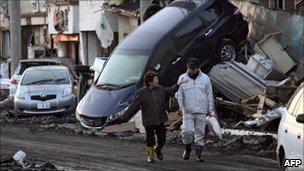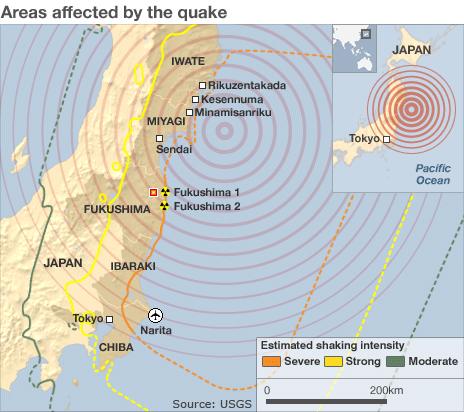Japan earthquake: Explosion at Fukushima nuclear plant
- Published
Damian Grammaticas reports on the destruction wrought by the tsunami in Sendai
A powerful explosion has hit a nuclear power station in north-eastern Japan which was badly damaged in Friday's devastating earthquake and tsunami.
A building housing a reactor was destroyed, but authorities said the reactor itself was intact.
The government sought to play down fears of a meltdown at the Fukushima 1 plant.
But officials later announced the cooling system of a second reactor at the plant had failed.
The news sparked fears of a the risk of a further explosion or leak of radioactive material.
A huge rescue and relief operation is under way in the region after the earthquake and subsequent tsunami, which are thought to have killed more than 1,000 people.
Tokyo Electric Power said four of its workers had been injured in Saturday's blast at Fukushima, 250km (155 miles) north of Tokyo, but that their injuries were not life-threatening.
An evacuation zone around the damaged nuclear plant has been extended to 20km (12.4 miles) from 10km, and a state of emergency declared.
An estimated 200,000 people have been evacuated from the area, the International Atomic Energy Agency says.
The government has urged residents to remain calm and is preparing to distribute iodine to anyone affected.
Tests showed at least three patients evacuated from a hospital near the plant had been exposed to radiation, public broadcaster NHK quoted local government officials as saying. They were among a group of people waiting outside the hospital for rescue helicopters when the explosion hit the plant.
Government spokesman Yukio Edano said the force of the explosion had destroyed the concrete roof and walls of a building around the plant's number one reactor, but a steel container encasing the reactor had not been ruptured.
Mr Edano said radiation levels around the plant had fallen after the explosion. He added that sea water was being pumped into the site to lower temperatures.
Before the explosion, Japan's nuclear agency had said that radioactive caesium and iodine had been detected near the number one reactor. The agency said this could indicate that containers of uranium fuel inside the reactor may have begun melting.
Air and steam, with some level of radioactivity, was earlier released from several of the reactors at both plants in an effort to relieve the huge amount of pressure building up inside.
Scenes of devastation
The tsunami that followed the 8.9-magnitude earthquake wreaked havoc along a huge stretch of on Japan's north-east coast, sweeping far inland and devastating a number of towns and villages.
The BBC's Damian Grammaticas in the coastal city of Sendai, in Miyagi prefecture, says the scenes of devastation there are astonishing - giant shipping containers have been swept inland and smashed against buildings, and fires are still burning close to the harbour.

The scale of the devastation is immense
Police said between 200 and 300 bodies were found in just one ward of the city.
The town of Rikuzentakada, Iwate, was reported as largely destroyed and almost completely submerged. NHK reported that soldiers had found up to 400 bodies there.
NHK reports that in the port of Minamisanriku, Miyagi, the authorities say that about 7,500 people were evacuated to 25 shelters after Friday's quake but they have been unable to contact the town's other 10,000 inhabitants.
A local official in the town of Futaba, Fukushima, said more than 90% of the houses in three coastal communities had been washed away by the tsunami.
"The tsunami was unbelievably fast," said Koichi Takairin, a 34-year-old truck driver who was inside his four-ton rig when the wave hit Sendai. "Smaller cars were being swept around me. All I could do was sit in my truck."
Tens of thousands of troops backed by ships and helicopters have been deployed on rescue and relief missions. More than 215,000 people are said to be living in 1,350 temporary shelters in five prefectures.
International disaster relief teams are being sent to Japan, with the United Nations helping to co-ordinate the operation.
President Barack Obama has pledged US assistance. One US aircraft carrier that was already in Japan will help with rescue and relief efforts, and a second is on its way.
Japan's worst previous earthquake was of 8.3 magnitude and killed 143,000 people in Kanto in 1923. A magnitude 7.2 quake in Kobe killed 6,400 people in 1995.
